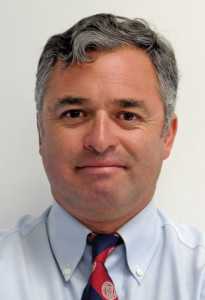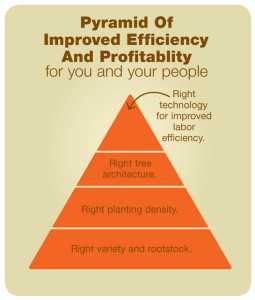How To Work Smarter, Not Harder In The Orchard
 Being an apple grower — whether you are a next-generation fruit grower, a newcomer, or a talented and already well recognized fruit grower — is one of the greatest professions of hard outdoor work. It requires having the right horticultural skills, but in addition you have to choose, implement, and execute good business strategies and you have to attract and hire the right group of people.
Being an apple grower — whether you are a next-generation fruit grower, a newcomer, or a talented and already well recognized fruit grower — is one of the greatest professions of hard outdoor work. It requires having the right horticultural skills, but in addition you have to choose, implement, and execute good business strategies and you have to attract and hire the right group of people.
In the last few years, I have tried to urge you to focus on orchard efficiency. I have also mentioned how critical the employees you hire are for the success of your business. I describe this by explaining you what I have called the “Pyramid for Efficiency and Profitability” which is supported by you and the people on your team.
 How The U.S. Compares To Other Tree Fruit-Growing Countries
How The U.S. Compares To Other Tree Fruit-Growing Countries
My unusual background has allowed me to see, compare, and connect things in a different way. Please let me give you some examples by comparing typical South American fruit operations from Chile, Argentina, or Brazil and typical Northeastern fruit operations from New York, Michigan, or Pennsylvania.
In the first case, the South American fruit operations are generally larger and corporate in nature, while here most of the operations are smaller and family run businesses. A Brazilian, Argentinian, or Chilean owner is less involved in day-to-day operations, while here you are more or fully involved. In general, South American fruit operations have more technical support (technicians, agronomists) and more consultants (university professors or private consultants). Here you have less technical support and fewer consultants involved.
Hand labor is less efficient, but more available and cheaper in South America, while labor here is less available and more expensive. An average Chilean or Brazilian orchard worker, for example, can pick three bins per day, while your pickers can pick five to six bins per day. Therefore, a typical South American fruit grower is currently “less ready” to improve orchard efficiency and also his or her employees! So what about you? Are you ready to improve your efficiency?
Are You Primed For Efficiency?
Progressive U.S. apple growers have been changing from big apple trees on seedling rootstock planted at large distances to more intensive planting systems (mainly on M.9) motivated by the economic need to modernize their fruit growing operations. They look for earlier yields after renewing the orchards, for better fruit quality, and for lower production costs compared to traditional systems. Many are now in a position to take advantage of labor-saving ideas and improve labor efficiency because they have the proper high-density orchard. Other growers who have not been modernizing their orchards can’t improve efficiency very much.
What Type Of Orchard Is Good For Improving Efficiency?
It’s one that allows for implementation of partial mechanization for production of high-quality fruit — a kind of assembly-line future for fruit production. It is also relatively simple. The more complicated you make the tree in terms of making decisions, the harder the system becomes for you and your workers.
With a simple training system, workers have to make few decisions. A simple training system also makes the fruitlets, branches, and fruit very accessible to workers for hand thinning, pruning, or harvest. Pruning is perhaps the best example I can use to explain this simplicity factor. Simple pruning rules make it easier for workers to be efficient in the orchard.
Complex tree architectures create many possible courses of action for pruning, which can confound workers. When they are faced with a abundance of pruning cut alternatives, workers are afraid of making the wrong choice. As a result, workers delay the pruning cut decision, default to the safest “obvious” cut, or avoid choosing altogether. Your pruning crew ends up being less efficient. They work harder not smarter.
Today our economy and the uncertainty of a skilled and reliable labor source force you to balance two conflicting, but equally important, demands for success at a critical moment in this country: (1) efficiency, which comes from exploiting standard opportunities and (2) flexibility, which allows a U.S. fruit grower to seize unexpected opportunities. It is a challenge because being a U.S. fruit grower demands a lot of your own personal and family time. Moreover, it is something you do outdoors expecting to make a profit in one of the few American industries “without a roof.” Simply, it is a huge challenge and a very risky thing if you commit horticultural or business management mistakes.
So ask yourself some tough questions:
- What is your goal as a fruit grower?
- Do you want to be among the best Northeastern fruit growers?
- Do you want to grow, pack, and sell your own fruit?
- Do you want to be fully vertically integrated?
- Do you want to produce fruit cheaper than others?
- Do you want to increase per-box returns by producing high quality fruit?
Once you define your business strategy, take steps to help yourself work smarter:
- Avoid wasting time shuffling through piles of papers or tools, and keep your desk, truck, shop, and ultimately, your orchard well organized.
- Prioritize a list of the tasks to carry out through the day, the next week, the next month, the coming season, and the next year.
- Envision where you and your family want to be the next 5 to 10 years.
- Prioritize the national and international educational conferences and tours you attend.
- Be smart and strategic when shopping for variety clubs, new technologies, or the next big idea.
- Try working in a team and allot tasks to co-workers, family members, and other helpers if possible.
- Have effective communication — change the focus from a top-down distribution of information to a bottom-up exchange of ideas with your key employees.
- Plan cautiously to make sure a job is done properly the first time around.
Hopefully, I have infused you with the mindset that allows improved efficiency and greater profitability. As with most things worth having, a culture of efficiency doesn’t just happen. It takes work. But the payoffs are priceless.










